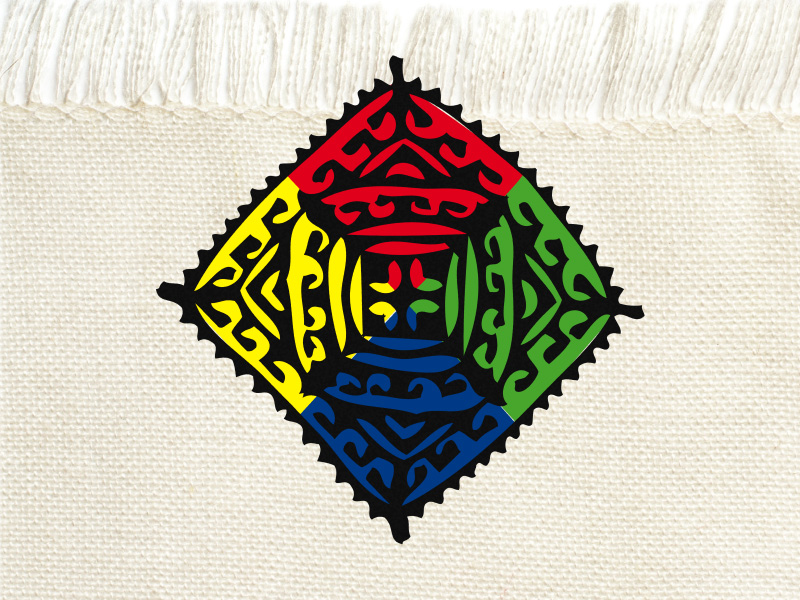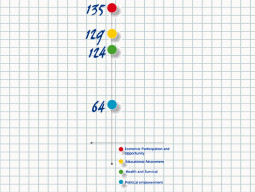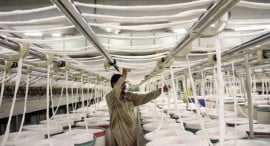
KHAIRPUR:
A splash of colours on both sides of the National Highway in the areas leading to and from village Haji Peer Bux Solangi in Thehri, district Khairpur, is a pretty sight. Countless rillis (patch-work quilts) of varying patterns are hung up for exhibit and sale.
The men on the road, safeguarding the rillis and entertaining the customers, usher buyers they know or trust to the women in the house. The women, who are responsible for these works of art, have spent days and weeks on each rilli quilt, bent upon them, putting pieces together with precision and passion.
In Pakistan’s rural areas, a well-known proverb is “it takes a village to raise a child”. Far from urban sensibilities, in most of rural Pakistan, people still work as a community and as a big family unit. But this particular village in Sindh consisting of 200 households takes it one step forward. They share not just the land they live on but are bound by earning through the same profession. Located far from the hustle and bustle of city life, this entire village relies on the rillis their women make as a source of earning. In this village, one sees a role model of sustainability, peace and development.
While the traditional and ancient art of rilli-making is practiced all over Sindh, it is not the only occupation in any one community, except for this village. Going to one of the houses, The Express Tribune saw the patchwork being done. “Putting patches together takes all day, but we train our girls to do it fast,” said Mukhtiar, the lady of the house who has the status of the head of the family. With the main earning members of this village being women, the set-up is almost matriarchal.
“I believe we women can even rule the world if given the opportunity,” said 18-year-old Neelum Solangi, who is in charge of a rilli-making training centre in the village. “Our women are exceptionally talented and dedicated towards benefitting the village,” she said, her doe-eyes wide in excitement.
When asked if it’s hard to train the daughters, Mukhtiar replied, “The patterns and technique come naturally to the girls.” She said they get down to doing it from the age of three.
“The prices range from Rs300 to Rs3,000,” said Imran, a son-in-law of one of the households.
“We use different kinds of cloth for our rilli,” said Qaim Khatoon, head of another household. “Our girls have become very creative with colours and designs, but we still maintain the traditional folk patterns,” she said, smiling.
Patching up dreams together
The word ‘rilli’ means ‘to connect’ or the conjoining of something. This artwork is used for quilts, cushions, sheets and even clothes. While the rilli was always made by hand, today machines have taken over.
The cultural significance of rillis can be gauged from the fact that no girl is sent to her new house after marriage without a rilli. Thus, Sindhi marriages are incomplete without the presence of rillis in a girl’s dowry and rillis are significant in celebrations, just like the ajrak.
When a guest arrives, a rilli will be spread out for the guest or is given to them to honour and acknowledge their coming to their house, as a sign of Sindh’s unrelenting tradition of hospitality.
The village hub
Across the road from the houses, in another corner of the village, a well-made brick house is a centre set up by Qurban Solangi, another villager. This serves as a rilli-making centre created with the help of district management and the Sindh government. The centre is called Peace Quilts and Crafts Organisation, which trains women and puts up better-designed and creative rilli, all pulled off by Neelum. “My father takes care of the logistics, while I solely take care of the creative side.” So far 200 women from the village have been trained in this centre to create better rillis.
Published in The Express Tribune, November 13th, 2013.
COMMENTS (14)
Comments are moderated and generally will be posted if they are on-topic and not abusive.
For more information, please see our Comments FAQ






















































Send this story and many more like this to those who stereotype our women being suppressed without knowing the actual problem.
True Story I like it
The writers mother is in 'rilli' business and have got a shop in defence where she sells it. Its good to read this article atleast someone is highlighting it for public and as well as own benefit.
@eiman: Taliban can not reach there. It is the land of Sufis!
better for the women of Khairpur that talibans'll not read this
I love all handicraft work. good job.
Fantabulous artical about rilli tradition in rural areas of sindh.
Very well written information about the progress women are making there. This is exactly how it must be, our women should assert themselves and actively participate in economic activities to add to family income and thus our national productivity as well. I wish the author has not claimed "....women rule", as the title suggests. I would prefer something like 'Women join the team' which connotes a more cooperative teamwork with mutual respect and equal pay.
It is time that the government set up CRAFT SHOPS in all major cities. These wonderful products can be purchased by the government and sold in such craft shops. The communities will benefit by receiving fair prices. The craft shops will create employment for poor people in the cities.
fabulous, awesome story,
won my heart ET keep it up
Why don't the news people give us more of such news that uplift peoples spirits and make them do better.
Wawo Amazing!!